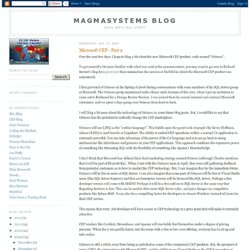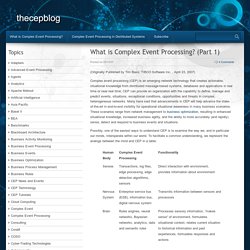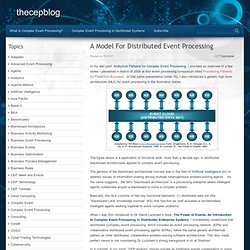

Concurrent Blocking MultiLane + Thoughts on Scala+Node.js+Akka. I 3 Votes MultiLane – A Concurrent Blocking Multiset offers some interesting reading in between coding Scala, and pondering on Akka+Node.js.

We introduce an extremely simple transformation that allows composition of a more scalable concurrent blocking multiset, or bag, from multiple “lanes” of a potentially less scalable underlying multiset. Our design disperses accesses over the various lanes, reducing contention and memory coherence hot spots. Implemented in Java, for instance, we construct a multiset from multiple lanes of java.util.concurrent.SynchronousQueue [9] that yields more than 8 times the aggregate throughput of a single instance of SynchronousQueue when run on a 64-way Sun Niagara-2 system with 16 producer threads and 16 consumer threads.
On the Scala road, essentially I’m interested in an architecture that leverage HTML5 SPI , Socket.IO/node.js for the last mile, and Scala/akka on the backend. Like this: Like Loading... Complex Event Processing. Complex Event Processing (kurz CEP , dt.

‚Verarbeitung komplexer Ereignisse‘) ist ein Themenbereich der Informatik , der sich mit der Erkennung, Analyse, Gruppierung und Verarbeitung voneinander Ereignisse (engl. Useful Stuff. SPARK streaming and other real time stream processing framework. Aaai 2011 event processing tutorial. Microsoft CEP - Part 2. Over the next few days, I hope to blog a bit about the new Microsoft CEP product, code-named "Orinoco".

To get yourself a bit more familiar with what was said at the announcement, you may want to go over to Richard Seroter's blog for a great post that summarizes the session at TechEd in which the Microsoft CEP product was announced. I first got wind of Orinoco in the Spring of 2008 during conversations with some members of the SQL Server group at Microsoft. The Orinoco group maintained radio silence until January of this year, when I got an invitation to come out to Redmond for a Design Review Session. I was joined there by several internal and external Microsoft customers, and we spent 2 days going over Orinoco from front to back. I will blog a bit more about the technology of Orinoco in some future blog posts. Orinoco will use LINQ as the "surface language". This means that every .Net developer will have access to CEP technology at a price point that will make it extremely attractive.
What is Complex Event Processing? (Part 1) Posted on 05/14/07 (Originally Published by Tim Bass, TIBCO Software Inc. , April 23, 2007) Complex event processing (CEP) is an emerging network technology that creates actionable, situational knowledge from distributed message-based systems, databases and applications in real time or near real time.

CEP can provide an organization with the capability to define, manage and predict events, situations, exceptional conditions, opportunities and threats in complex, heterogeneous networks. Many have said that advancements in CEP will help advance the state-of-the-art in end-to-end visibility for operational situational awareness in many business scenarios. These scenarios range from network management to business optimization, resulting in enhanced situational knowledge, increased business agility, and the ability to more accurately (and rapidly) sense, detect and respond to business events and situations.
Table 1: Human Cognitive Functions and CEP Functionality Figure 1. Workshop on Event Processing – Presentations. TIBCO_MARCH_2006. A Model For Distributed Event Processing. Posted on 11/01/07 In my last post, Analytical Patterns for Complex Event Processing, I provided an overview of a few slides I presented in March of 2006 at first event processing symposium titled Processing Patterns for Predictive Business.

In that same presentation (slide 15), I also introduced a generic high level architecture (HLA) for event processing in the illustration below: The figure above is a application of historical work, more than a decade ago, in distributed blackboard architectures applied to complex event processing. The genesis of the blackboard architectural concept was in the field of Artificial Intelligence (AI) to address issues of information sharing among multiple heterogeneous problem-solving agents.
As the name suggests, the term “blackboard architecture” is a processing metaphor where intelligent agents collaborate around a blackboard to solve a complex problem. When I was first introduced to Dr. Amazon. Real-time computing. In computer science, real-time computing (RTC), or reactive computing, is the study of hardware and software systems that are subject to a "real-time constraint", for example operational deadlines from event to system response.

Real-time programs must guarantee response within strict time constraints, often referred to as "deadlines".[1] Real-time responses are often understood to be in the order of milliseconds, and sometimes microseconds. Conversely, a system without real-time facilities, cannot guarantee a response within any timeframe (regardless of actual or expected response times). The use of this word should not be confused with the two other legitimate uses of "real-time". In the domain of simulations, the term means that the simulation's clock runs as fast as a real clock. In the processing and enterprise systems domains, the term is used to mean "without perceivable delay". History[edit] Complex event processing. Event processing is a method of tracking and analyzing (processing) streams of information (data) about things that happen (events),[1] and deriving a conclusion from them. Complex event processing, or CEP, is event processing that combines data from multiple sources[2] to infer events or patterns that suggest more complicated circumstances.
The goal of complex event processing is to identify meaningful events (such as opportunities or threats)[3] and respond to them as quickly as possible. These events may be happening across the various layers of an organization as sales leads, orders or customer service calls. FACH_0112. CEP/ESP » Lab49 Blog.